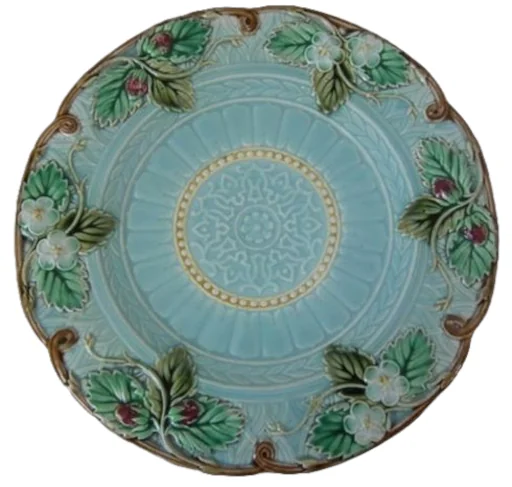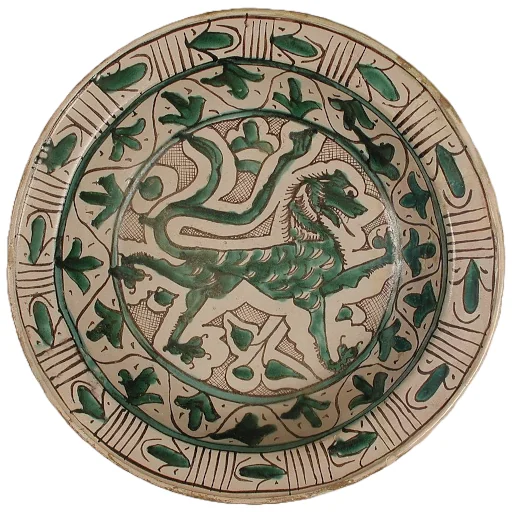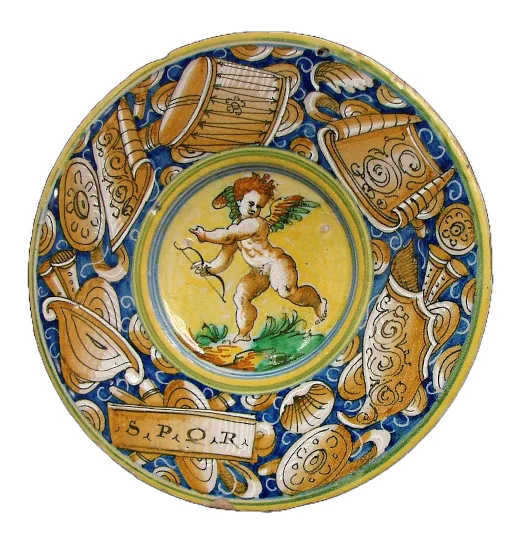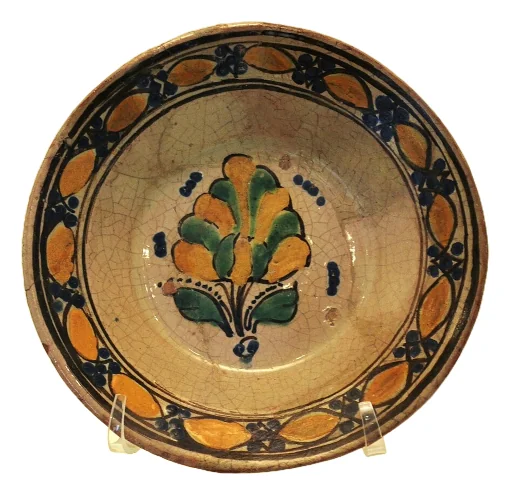It refers to two distinct pottery types: Italian Maiolica, known for its tin-glazed, detailed artistic designs from the Renaissance, and Victorian Majolica, characterized by its vibrant, lead-glazed earthenware popular in 19th-century England.
Majolica tells stories. It’s like each piece is a chapter from history, painted right there on the clay.
These potters, they weren’t just making something to eat off of; they were capturing life. You’ve got scenes from everyday life, myths, legends, even bits of political satire, all baked into these plates and vases. It’s like reading a book about what folks thought, believed, and laughed at back then.
And the thing about Majolica is, it changed with the times. In the Renaissance, you’ve got these elaborate scenes from classical stories. Then, in Victorian times, it’s all about the beauty of nature and a touch of fairy-tale whimsy. Majolica was kind of like a mirror, reflecting what was going on in the world.
Majolica pieces that are more than just art. They’re snapshots of history, showing what people wore, what was on their minds, how they saw the world. That’s the real magic of Majolica. It’s not just pottery; it’s a window into the past, showing us how much we’ve changed and, in some ways, how we’ve stayed the same.
A Canvas For Expression
Majolica was much more than just functional or decorative pottery. It was a canvas for expression, capturing the essence of the times, the interests of the people, and the prevailing cultural and political climates. This makes Majolica not just an art form but a valuable historical record, offering insights into the lives and thoughts of those who lived in those eras.
- Renaissance Maiolica: In Italian Renaissance Maiolica, you often find scenes from mythology and classical literature. For instance, a plate might depict a scene from Ovid’s “Metamorphoses” or an event from Roman history. These pieces were like visual interpretations of popular stories and educational themes of the time, reflecting the Renaissance’s revival of classical learning and art.
- Victorian Majolica: In contrast, Victorian-era Majolica from England often featured designs inspired by the natural world and the whimsy of fairy tales. You’d see vibrant plates with scenes of lush gardens, exotic animals, or fantastical creatures like dragons and fairies. This reflected the Victorian fascination with nature, exploration, and the fantastical elements of storytelling.
- Political and Social Commentary: Some Majolica pieces served as a form of social or political commentary. For example, during certain periods, you might find pieces subtly critiquing a political figure or policy, using symbolism and allegory to convey the message. This kind of Majolica served as a discreet way to express opinions in a time when direct criticism could be dangerous.
My Personal Story
Personal Story and Unique Perspectives on Majolica
My journey with Majolica pottery began unexpectedly at a yard sale in a small town in Tennessee. Among the eclectic mix of items, a modestly decorated Majolica teapot caught my eye. It wasn’t extravagant, but its cheerful colors and simple floral pattern had a certain charm. The seller, a friendly local, mentioned it was a family heirloom, possibly Victorian-era Majolica. This piqued my curiosity and marked the start of my affinity for Majolica.
As I delved into the world of Majolica, my collection grew modestly, with pieces that are more quaint than grandiose. Each find, like the small Maiolica dish with a faded pastoral scene I discovered at a community thrift store, added a bit of history to my home. These aren’t museum-quality pieces, but they hold a certain allure, connecting me to a bygone era.
I’ve found Majolica in the most unexpected places. A chipped Victorian Majolica vase I stumbled upon at a flea market in a nearby city was far from perfect, yet its imperfections spoke of its journey through time. Despite its flaws, it stood out with its bold glaze and a slightly worn botanical motif, reminiscent of the Victorian era’s love for nature.
My approach to collecting Majolica is practical. I focus on pieces that can be incorporated into my daily life. Whether it’s using a Majolica plate for special dinners or displaying a small vase on my bookshelf, these pieces add a touch of history and art to my routine.
This hobby has also made me conscious of preservation. I’ve learned to handle these pieces with care, appreciating their fragility and the stories they carry.
While my Majolica collection might not be the most valuable in monetary terms, its true value lies in the stories and the connection to the past. Each piece, with its humble beauty and imperfect charm, is a small window into the world of antique pottery. My journey with Majolica, from that first yard sale find to the latest addition, is a testament to the joy of discovering beauty in unexpected places.
Majolica pottery, a term with a rich historical tapestry, encapsulates two distinct styles of ceramics, each with its unique origin, technique, and artistic expression.
“Philip English, president of the Majolica International Society based in New York City, advises new collectors of majolica pottery to focus on acquiring pieces that are not only aesthetically pleasing but also practical. Fortunately, finding such functional majolica pieces is usually quite straightforward, according to English.”
Introduction to Majolica Pottery
Definition and Overview
Majolica refers to a specific type of pottery celebrated for its vibrant colors and intricate designs. Originating in Europe, it has evolved through centuries, embodying both artistic finesse and functional value.1
Distinction between Maiolica and Victorian Majolica
- Maiolica:
- Origin: Traces back to the Renaissance era in Italy.
- Technique: Known for its tin-glazed process, yielding an opaque white surface.
- Artistry: Features brush-painted, detailed scenes and patterns, often reflecting historical and allegorical themes.
- Cultural Significance: Favored by the elite, including prominent families like the Medici.
- Victorian Majolica:
- Origin: Gained popularity in 19th-century England, notably Victorian era.
- Technique: Characterized by its colored lead silicate glazes, applied directly to create bright, durable wares.
- Designs: Often showcases naturalistic and whimsical forms, aligning with the Victorian aesthetic.
- Mass Production: Introduced at the 1851 Great Exhibition in London, it saw widespread production and appeal.
Both forms of Majolica, while distinct in their origins and techniques, share a common thread of being highly valued in their respective eras for their beauty and craftsmanship.
Historical Context and Global Influence
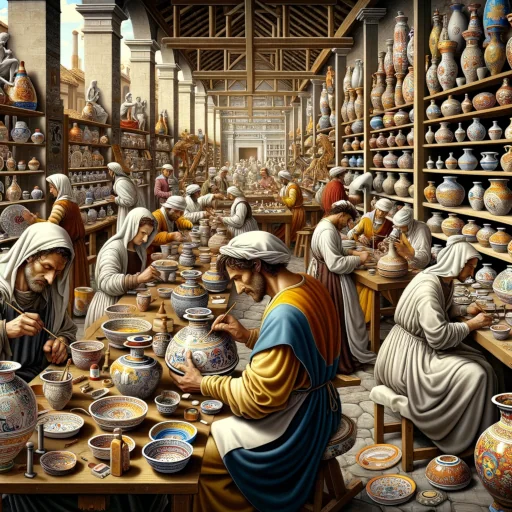
Origins and Spread of Majolica
Majolica’s story is a journey through time and geography, from its early roots to its global reach.
Origin in Italy and England
- Italy: Majolica’s inception dates back to the Renaissance period. Italian Maiolica emerged as a revered art form, known for its exquisite tin-glazed pottery, flourishing in regions like Florence and deeply intertwined with the cultural reawakening of the era.
- England: The Victorian era witnessed the birth of a different kind of Majolica in England. This style, characterized by vibrant lead glazes, became synonymous with 19th-century English ceramics, reflecting the period’s ornate tastes and industrial advancements.
Influence on Global Pottery and Art History
- Cultural Exchange: Majolica’s spread from Italy and England to other parts of Europe and beyond was facilitated by trade, cultural exchange, and the global expansion of European powers.
- Artistic Evolution: As Majolica traveled, it influenced and was influenced by local art and pottery styles, leading to diverse interpretations and adaptations.
- Global Recognition: From its Renaissance roots to its Victorian peak, Majolica has been celebrated for its artistic beauty and innovation, securing a lasting legacy in the world of fine art and pottery. Its influence can be seen in modern ceramics and designs, reflecting a blend of historical artistry and contemporary creativity.
Technological Advancements in Production
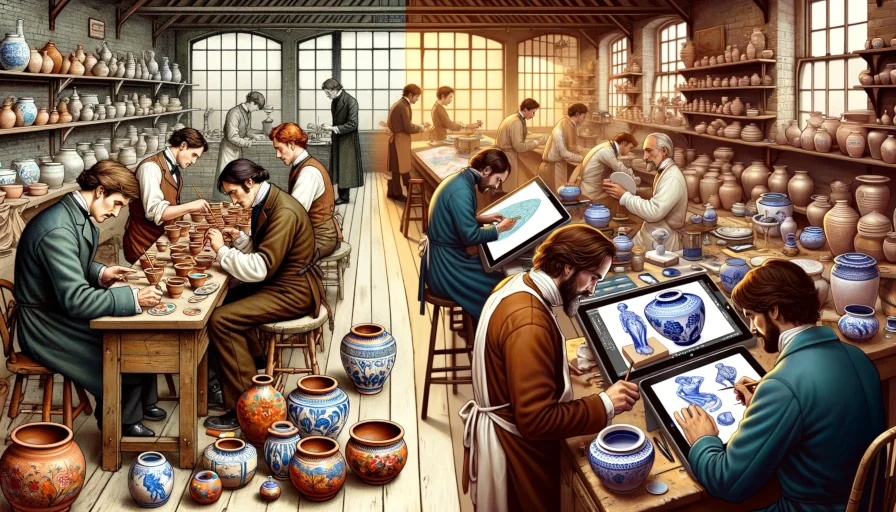
Majolica pottery, a fusion of art and craft, has undergone significant technological transformations from its inception to modern-day replication and preservation.
Historical Production Techniques
Majolica’s manufacturing process, whether Italian Maiolica or Victorian Majolica, involves unique techniques that define its aesthetic.
Italian Maiolica:
- Tin-Glazing: The process starts with bisque firing the clay, followed by applying a tin oxide glaze, creating an opaque white base.
- Decorative Painting: Artists then hand-paint intricate designs using metal oxide enamels before the second firing.
- Victorian Majolica:
- Lead-Glazing: This method involves applying brightly colored lead silicate glazes directly to the bisque-fired pottery.
- One-Step Firing: Unlike Maiolica, Victorian Majolica usually undergoes a single firing process after glaze application.
Modern Replication and Preservation
Advancements in technology have not only made replication more precise but also enhanced the preservation of these historical pieces.
Replication Techniques:
- Digital Imaging: Modern tools allow for detailed study and replication of historical patterns and colors.
- Advanced Kilns: Contemporary kilns offer better temperature control, crucial for replicating delicate glazing techniques.
- Preservation Efforts:
- Restoration Technologies: Techniques like 3D printing and laser scanning aid in the restoration of damaged Majolica pieces.
- Conservation Science: Chemical analysis and conservation treatments help in understanding the original materials and techniques, ensuring the preservation of Majolica’s legacy for future generations.
The evolution of Majolica from handcrafted artistry to high-tech replication and preservation reflects a blend of tradition and innovation, ensuring that its historical significance and beauty are maintained and appreciated in the modern era.
Artistic Styles and Influences
Majolica pottery, with its rich heritage and distinctive styles, has left an indelible mark on the artistic world. Its evolution reflects a fascinating interplay of cultural, historical, and artistic influences.2
Comparative Artistic Analysis
The artistic journey of Majolica is a tale of two distinct styles: Italian Maiolica and Victorian Majolica.
Artistic Comparison of Maiolica and Victorian Majolica
Maiolica:
- Visual Characteristics: Characterized by its intricate brushwork and detailed imagery. The designs often include historical, religious, or mythological scenes, rendered in a vibrant yet limited color palette due to the tin-glaze technique.
- Cultural Significance: Maiolica served as a canvas for Renaissance artists to express ideas and values of the time, often used as a symbol of wealth and status.
Victorian Majolica:
- Visual Characteristics: Known for its bold, bright colors and naturalistic themes. This style often features botanical motifs, animals, and ornate patterns.
- Cultural Significance: Reflecting the Victorian era’s fascination with nature and the exotic, these pieces were more about aesthetic appeal and mass appeal, aligning with the industrial era’s capabilities.
Influence of Cultural and Historical Contexts on Designs
- Maiolica: The Renaissance influence is evident in Maiolica’s emphasis on humanism, detailed portraiture, and classical motifs.
- Victorian Majolica: Mirrors the Victorian era’s industrial progress and societal changes, embracing both the natural world and the technological advancements of the time.
Modern Art and Design Influences
Majolica continues to inspire contemporary artists and designers, its legacy evident in various modern works.
Majolica’s Inspiration in Contemporary Art
- Aesthetic Influence: Modern artists often draw on Majolica’s vivid color schemes and intricate designs, incorporating them into various media, from ceramics to textiles.
- Conceptual Influence: The fusion of function and form seen in Majolica resonates with contemporary designers, who blend utility with artistic expression.
Examples of Modern Works Influenced by Majolica
- Ceramic Art: Many contemporary ceramicists reference Majolica’s techniques and styles, creating pieces that echo its historical motifs with a modern twist.
- Fashion and Interior Design: Elements of Majolica can be seen in bold, patterned fabrics and decorative home accessories, reflecting its enduring influence on design trends.
Majolica Pottery: A Collector’s Guide
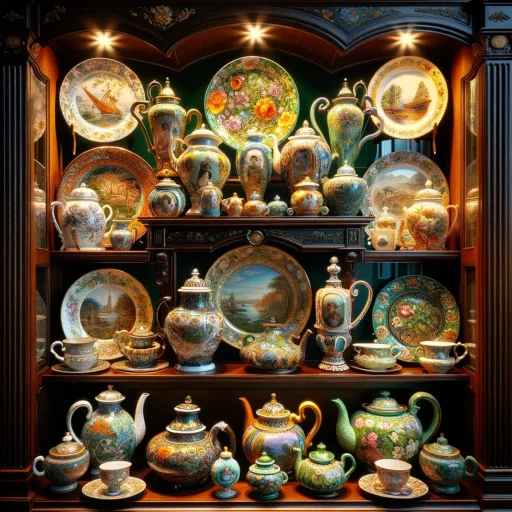
Collecting Majolica
As a collector, my journey into the world of Majolica pottery has been enriching. The unique charm and historical significance of these pieces make them a prized addition to any collection.
Authenticating and Appraising Majolica
- Authenticating: I’ve learned the importance of examining the glaze, markings, and craftsmanship to authenticate Majolica. Consulting experts and using resources like the Majolica International Society can be invaluable.
- Appraising: The value of Majolica depends on factors like age, rarity, and condition. I recommend seeking professional appraisals for accurate valuation.
Tips for Preservation and Display
- Preservation: Proper care is essential. I avoid exposing Majolica to extreme temperatures and humidity, and I handle these pieces gently to prevent chips or cracks.
- Display: Displaying Majolica in well-lit, stable environments showcases its beauty. Using secure shelving or cabinets protects the pieces from accidental damage.
Trends in Majolica Collecting
The world of Majolica collecting is dynamic, with evolving trends and interests.
Current and Future Trends in Majolica Collecting
- Current Trends: Currently, there’s a growing interest in unique and historically significant pieces. Collectors are also valuing pieces with unusual designs or stories.
- Future Trends: I anticipate a continued appreciation for Majolica, with an increasing focus on sustainable collecting and preservation of these historical pieces.
Majolica in the Antique Market and as an Investment
- Antique Market: Majolica holds a steady place in the antique market. Its appeal lies in its artistic merit and historical significance.
- Investment: While I view Majolica primarily as a cultural and artistic investment, certain rare pieces can also be financially valuable, especially as the market for antique ceramics grows.
Collecting Majolica is not just about acquiring objects; it’s about preserving a piece of history and artistry. Each piece tells a story, connecting us to the past and enriching our present.3
Gallery of Majolica images
Colored lead glazes majolica, flowers moulded in high relief. Shape first shown at the 1851 Exhibition by Minton & Co., Exhibit Number 60 Colored lead glazes Palissy majólica, mottled glazes, applied fruits, late 19th century, Elias, Portugal Sarreguemines Majolica Majolique plate, moulded in relief, late 19th century, France Earthenware, tin-glaze (Majolica), early 15th century, Italy. Metropolitan Museum NY Majolica Canopic Jar
Tin-glazed majolique armoriée, France, late 16th century. Italian Renaissance Grotesque style Tin-glazed Italian Renaissance maiolica, 1550–1570 Tin-glazed 17th century Talavera, also called majolica, Mexico
Conclusion and Summary
Reflecting on my journey with Majolica pottery, I’ve come to appreciate its profound artistic, historical, and cultural significance. Majolica is not just about ornate ceramics; it’s a vibrant narrative of human creativity and cultural evolution.
From the intricate Italian Maiolica, which captures the essence of the Renaissance with its detailed, mythological depictions, to the Victorian Majolica, reflecting the industrial advancement and the Victorian love for the ornate and the natural, each piece tells a unique story. These styles, though centuries apart, share a common thread of artistic mastery and cultural representation.
As I’ve delved deeper into the world of Majolica, I’ve seen how it bridges the gap between the past and the present. In my collection, each Majolica piece is a testament to the enduring appeal of this art form. They stand as a reminder of the human capacity for beauty and innovation, transcending time and trends.
Majolica’s impact extends beyond the realm of antiques and into the sphere of modern art. Contemporary artists and designers draw inspiration from its vivid colors and patterns, blending traditional techniques with modern sensibilities. This fusion highlights Majolica’s ongoing relevance and adaptability, proving that it is as much a part of today’s artistic landscape as it was centuries ago.
In conclusion, my experience with Majolica has been more than collecting pottery; it has been a journey through history, art, and culture. Majolica’s enduring appeal lies in its ability to tell stories, to connect us with our past, and to inspire future generations of artists and collectors. As I look at my collection, each piece resonates with a sense of timelessness, a piece of history preserved in clay, continuing to enchant and educate in the ever-evolving world of fine art.
Majolica Pottery FAQ
How Can You Tell Majolica?
Identifying Majolica involves looking for certain characteristics:
- Glaze and Color: Majolica is known for its vibrant, often jewel-toned glaze. The colors are typically glossy and can range from deep blues and greens to earthy browns and yellows.
- Designs and Patterns: Look for naturalistic designs like leaves, flowers, and animals, particularly in Victorian Majolica. Italian Maiolica often features detailed human figures or mythological scenes.
- Markings: Check the bottom for maker’s marks, which can help identify the age and origin.
- Texture: Majolica pieces often have a distinct three-dimensional quality, with designs that are slightly raised from the surface.
What Does Majolica Mean in Pottery?
In pottery, Majolica refers to two main types of glazed earthenware:
- Italian Maiolica: This is characterized by a tin-glazed technique that provides a white, opaque background for detailed, enamel-painted designs.
- Victorian Majolica: Known for its bright, lead-glazed earthenware, this style often features bold colors and naturalistic themes.
Is Majolica Worth Anything?
- The value of Majolica depends on several factors including age, condition, rarity, and the maker. Antique Majolica from renowned makers or unique pieces can be quite valuable. However, the market fluctuates, and not all Majolica pieces command high prices.
Is Majolica Still Made Today?
- Yes, Majolica is still produced today. Contemporary artisans often use traditional techniques to create pieces that pay homage to the historical styles of Majolica, while others infuse modern elements into their designs.
What is Majolica Made Of? How to Identify Majolica
- Materials: Majolica is typically made of earthenware, a type of ceramic made from clay.
- Identification: To identify Majolica, apart from looking at glaze and design, consider the weight and feel of the piece. Majolica usually has a substantial, sturdy feel. Modern reproductions might feel lighter and less detailed.
Footnotes
- Karmason, Marilyn G.., Stacke, Joan B.. Majolica: A Complete History and Illustrated Survey. United Kingdom: Harry N. Abrams, 2002. ↩︎
- Katz-Marks, Mariann. Majolica Pottery. United States: Collector Books, 1989. ↩︎
- Katz-Marks, Mariann. Majolica Pottery: An Identification and Value Guide. Second series. United States: Collector Books, 1986. ↩︎


